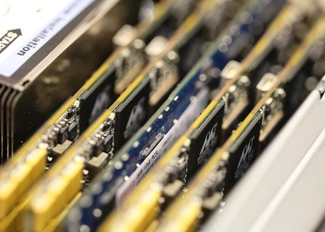
ULLtraDIMM Solid-State Drives Arrive from SanDisk
SanDisk has announced the availability of its ULLtraDIMM solid-state drive that comes in DDR3 DIMM form factor as well as with MLC NAND flash memory made using 19nm process technology. ULLtraDIMM SSDs redefine the standard of low-latency storage by placing flash as close as possible to the CPU (directly in the DIMM slot). Its infrastructure dictates exceptional performance for application acceleration, achieving ridiculous read/write times. The ULLtraDIMM can pull off an astonishing 5 microsecond read latency, which is 10 times faster than PCIe-based SSDs and 30 times faster than SATA-based SSDs. Furthermore, system capacity scales linearly with each additional ULLtraDIMM without impacting latency. ULLtraDIMM SSDs come in 200 GB or 400 GB versions, provide up to 1000MB/s read speed, up to 760MB/s write speed as well as 150K/65K read/write IOPS.
| ULLtraDIMM SSD | PCIe SSD | SATA SSD | |
| Brand | Sandisk | OCZ Storage | Samsung |
| Write Latency | <5 µsec | 50 µsec | 150 µsec |
| Random Read IOPS | 150k | 130k | 100k |
Before ULLtraDIMM SSDs, storage was one of the greatest bottlenecks for GPU-accelerated virtualization applications. The ULLtraDIMM greatly increases computational speeds in virtual environments (VDI), big data analytics, finance applications, and database and high-frequency messaging. 50 full capacity writes per day can take place, whereas standard SSDs will only allow a maximum of 1 write per day. It also contains corruption protection technology along all paths in the SSD and the ability to recover lost data from NAND blocks and unexpected power interruptions.
Although ULLtraDIMM solutions can be pricey, companies can benefit greatly from the increased computational speeds for enterprise workloads. SanDisk has already begun shipping ULLtraDIMM SSDs to key channel partners, including Exxact Corporation. The Exxact Tensor IXR110-512N-U, for example, is equipped with dual Intel Xeon E5 v2600 CPUs while providing 14x 400 GB ULLtraDIMM modules (5.6 TB flash storage) – ideal for applications where write latency is more important than IOPS performance. If the end-user prefers less storage capacity, the Exxact Tensor IXR111-512N-U can get the job done in similar fashion with 14x 200 GB ULLtraDIMM modules (2.8 TB flash storage). Exxact’s ULLtraDIMM-based systems can help reduce read/write times and maximize efficiency for enterprise applications.

ULLtraDIMM Solid-State Drives Arrive from SanDisk
ULLtraDIMM Solid-State Drives Arrive from SanDisk
SanDisk has announced the availability of its ULLtraDIMM solid-state drive that comes in DDR3 DIMM form factor as well as with MLC NAND flash memory made using 19nm process technology. ULLtraDIMM SSDs redefine the standard of low-latency storage by placing flash as close as possible to the CPU (directly in the DIMM slot). Its infrastructure dictates exceptional performance for application acceleration, achieving ridiculous read/write times. The ULLtraDIMM can pull off an astonishing 5 microsecond read latency, which is 10 times faster than PCIe-based SSDs and 30 times faster than SATA-based SSDs. Furthermore, system capacity scales linearly with each additional ULLtraDIMM without impacting latency. ULLtraDIMM SSDs come in 200 GB or 400 GB versions, provide up to 1000MB/s read speed, up to 760MB/s write speed as well as 150K/65K read/write IOPS.
| ULLtraDIMM SSD | PCIe SSD | SATA SSD | |
| Brand | Sandisk | OCZ Storage | Samsung |
| Write Latency | <5 µsec | 50 µsec | 150 µsec |
| Random Read IOPS | 150k | 130k | 100k |
Before ULLtraDIMM SSDs, storage was one of the greatest bottlenecks for GPU-accelerated virtualization applications. The ULLtraDIMM greatly increases computational speeds in virtual environments (VDI), big data analytics, finance applications, and database and high-frequency messaging. 50 full capacity writes per day can take place, whereas standard SSDs will only allow a maximum of 1 write per day. It also contains corruption protection technology along all paths in the SSD and the ability to recover lost data from NAND blocks and unexpected power interruptions.
Although ULLtraDIMM solutions can be pricey, companies can benefit greatly from the increased computational speeds for enterprise workloads. SanDisk has already begun shipping ULLtraDIMM SSDs to key channel partners, including Exxact Corporation. The Exxact Tensor IXR110-512N-U, for example, is equipped with dual Intel Xeon E5 v2600 CPUs while providing 14x 400 GB ULLtraDIMM modules (5.6 TB flash storage) – ideal for applications where write latency is more important than IOPS performance. If the end-user prefers less storage capacity, the Exxact Tensor IXR111-512N-U can get the job done in similar fashion with 14x 200 GB ULLtraDIMM modules (2.8 TB flash storage). Exxact’s ULLtraDIMM-based systems can help reduce read/write times and maximize efficiency for enterprise applications.




